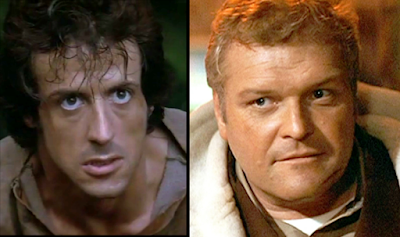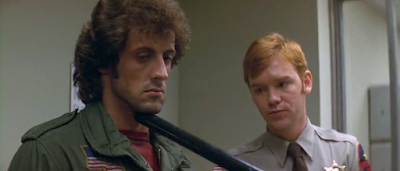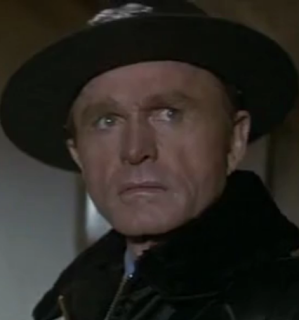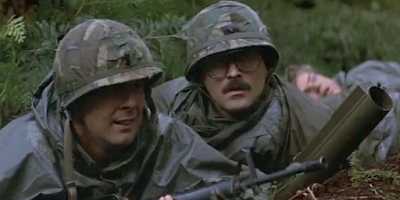Many film-watchers are aware of the artistic techniques and aesthetic choices such as camera angles, music, and lighting which are used in film, but less are consciously aware of the deliberate aesthetic choices regarding the appearance (specifically the face shape) of the actors. Perhaps this is because the archetypical differences in face shapes are often intuitively understood, unlike camera angles for instance which are often consciously studied.
Let us examine the face shapes in a classic American movie. (Spoilers below).
In First Blood, John Rambo (played by Sylvester Stallone) is a Vietnam veteran who drifts into a small town where he is immediately harassed by the town's sheriff Will Teasle (played by Brian Dennehy). Teasle tells Rambo that a vagrant like him, especially one with a flag on his Army jacket, is not welcome in his town. The sheriff drives Rambo out of town, but Rambo soon turns around and begins to walk back rather than continue walking 30 miles to the next town. Furious at Rambo's defiance and indifference towards his "authority", Teasle arrests Rambo.
At the police station, the officers are seen wearing uniforms with American flag patches of the same size that Rambo has on his jacket, revealing the absurd hypocrisy of Teasle's earlier statement. Rambo refuses to speak and cooperate, but does not act out against the police until the sadistic officer Art Galt (played by Jack Starrett) triggers flash backs of Rambo's time being tortured as a POW.
Rambo becomes enraged and escapes the police station with little effort, shattering the illusion of power that the police hold. A manhunt ensues and Teasle orders that Rambo is to be captured alive, but Galt is bent on killing Rambo and later falls to his death after recklessly pursuing him. Rambo comes out to surrender after Galt dies, because he wants no further blood to be shed. Teasle, who is angered by the death of Galt, ends up shooting at Rambo (again revealing his hypocrisy since he told Galt he wanted to capture Rambo alive a few seconds ago).
Teasle's arrogance is further illustrated when the state police, National Guard, and Rambo's former Army commander, Colonel Trautman (played by Richard Crenna), are brought into the manhunt. Teasle insists on doing things his way, but the viewer is keenly aware by now that Rambo's skills are superior to Teasle's. He demands that the National Guardsmen hunting Rambo do not shoot, but the film immediately cuts to a shootout scene between Rambo and the Guardsmen. The shooting stops when Rambo fires back and the Guardsmen are too afraid to return fire--unambiguously showing us who is really in control.
Later, Teasle admits his desire to kill Rambo to Trautman, showing that his earlier commands to take Rambo alive were presumably so Teasle would have the personal "honor" of killing him.
The differences in personality between the characters are mirrored by their differences in physical appearance, most notably their face shapes. Stallone has an Oblong-leaning face while Dennehy, the other police officers, and most of the National Guardesmen have Round or Square-leaning faces. The officers also appear to be at least a generation older than Rambo, although in real life Dennehy is just 8 years older than Stallone!
At the police station, Rambo appears calm and reserved, which is juxtaposed with the officers' chitchat amongst themselves and their hot-tempered orders directed towards Rambo. Rambo's steely demeanour matches up well with his long, chiselled face and provides an excellent contrast towards the officers' soft-featured, wide faces.
The officers wind up abusing Rambo due to his refusal to cooperate; however, recall that Rambo's defiance is caused by the officers' unjust arrogance in the first place. The only officer who appears disturbed by the sadistic treatment is the young officer, whose face is more Oval-leaning than any of the other policemen.

The police decide to hold Rambo down and give him a dry shave. This triggers flashbacks of being tortured in Vietnam.

Rambo just wanted directions to a diner, yet the officers act maliciously towards him for no justified reason.
Later in the film we meet the State Police/National Guard leader and Rambo's former commander, Colonel Trautman. The State Police commander has a Square face, which complements officer Teasle's round face, as well as the wide-faced Guardsmen under his command. Trautman on the other hand appears to have a Oval-leaning face, and although his skin has sagged and wrinkled from age he stands our in stark contrast to the other two men. His face also complements Rambo's long face.
Personality-wise, Trautman is portrayed as calm and rational. This is contrary to Teasle who has a short temper and orders the manhunt to proceed recklessly despite being warned, and contrary to the State Policeman who acquiesces to Teasle, despite the fact that the manhunt may have gone out of Teasle's jurisdiction.
After the National Guardsmen trap Rambo in an abandoned mine, they become petrified in fear when he returns fire. Too cowardly to advance into the mine and capture him, they decide to blow the mine up. They mistakenly believe this kills Rambo, and proceed to celebrate by posing for a "heroic" photo which they hope will be featured in newspapers and magazines.
While Teasle and the State Police commander are willing to sacrifice the lives of their troops to capture Rambo (recall that he was originally arrested for vagrancy and was willing to surrender without bloodshed earlier!), Trautman comes alone, and offers his personal assistance as an individual. Empathetically viewing Rambo as an individual, rather than a fugitive who needs to be destroyed, an unarmed Trautman eventually walks right in front of the machine-gun-wielding Rambo and convinces him to surrender. This is just moments after the assault-rifle-wielding Teasle is pitifully gunned down.

Teasle's arrogance manages to escalate the situation from Rambo merely asking for directions to Rambo destroying the whole town, but Trautman is able to stop Rambo.
In recent pop culture, Rambo is one of the most famous examples of a 'freedom fighter' character defying a corrupt system. We should ask ourselves: would Rambo have been as convincing of a hero had Dennehy, or any of the other policemen, switched roles with Stallone? If not, is it because certain face shapes correlate more strongly with the heroic archetype than others?








